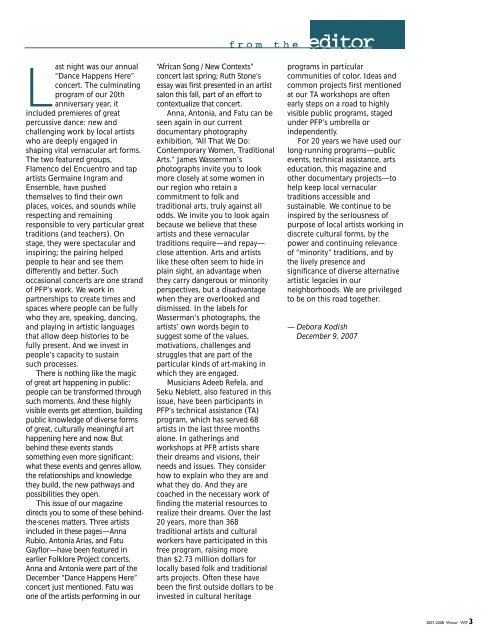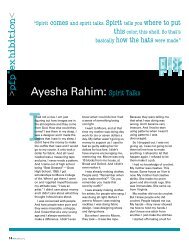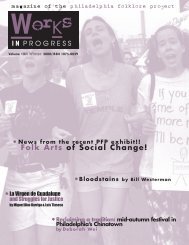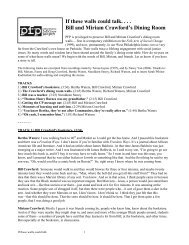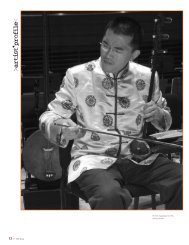African song / Fatu Gayflor ⢠War and wealth - Philadelphia Folklore ...
African song / Fatu Gayflor ⢠War and wealth - Philadelphia Folklore ...
African song / Fatu Gayflor ⢠War and wealth - Philadelphia Folklore ...
Create successful ePaper yourself
Turn your PDF publications into a flip-book with our unique Google optimized e-Paper software.
from the<br />
editor<br />
Last night was our annual<br />
“Dance Happens Here”<br />
concert. The culminating<br />
program of our 20th<br />
anniversary year, it<br />
included premieres of great<br />
percussive dance: new <strong>and</strong><br />
challenging work by local artists<br />
who are deeply engaged in<br />
shaping vital vernacular art forms.<br />
The two featured groups,<br />
Flamenco del Encuentro <strong>and</strong> tap<br />
artists Germaine Ingram <strong>and</strong><br />
Ensemble, have pushed<br />
themselves to find their own<br />
places, voices, <strong>and</strong> sounds while<br />
respecting <strong>and</strong> remaining<br />
responsible to very particular great<br />
traditions (<strong>and</strong> teachers). On<br />
stage, they were spectacular <strong>and</strong><br />
inspiring; the pairing helped<br />
people to hear <strong>and</strong> see them<br />
differently <strong>and</strong> better. Such<br />
occasional concerts are one str<strong>and</strong><br />
of PFP’s work. We work in<br />
partnerships to create times <strong>and</strong><br />
spaces where people can be fully<br />
who they are, speaking, dancing,<br />
<strong>and</strong> playing in artistic languages<br />
that allow deep histories to be<br />
fully present. And we invest in<br />
people’s capacity to sustain<br />
such processes.<br />
There is nothing like the magic<br />
of great art happening in public:<br />
people can be transformed through<br />
such moments. And these highly<br />
visible events get attention, building<br />
public knowledge of diverse forms<br />
of great, culturally meaningful art<br />
happening here <strong>and</strong> now. But<br />
behind these events st<strong>and</strong>s<br />
something even more significant:<br />
what these events <strong>and</strong> genres allow,<br />
the relationships <strong>and</strong> knowledge<br />
they build, the new pathways <strong>and</strong><br />
possibilities they open.<br />
This issue of our magazine<br />
directs you to some of these behindthe-scenes<br />
matters. Three artists<br />
included in these pages—Anna<br />
Rubio, Antonia Arias, <strong>and</strong> <strong>Fatu</strong><br />
<strong>Gayflor</strong>—have been featured in<br />
earlier <strong>Folklore</strong> Project concerts.<br />
Anna <strong>and</strong> Antonia were part of the<br />
December “Dance Happens Here”<br />
concert just mentioned. <strong>Fatu</strong> was<br />
one of the artists performing in our<br />
“<strong>African</strong> Song / New Contexts”<br />
concert last spring; Ruth Stone’s<br />
essay was first presented in an artist<br />
salon this fall, part of an effort to<br />
contextualize that concert.<br />
Anna, Antonia, <strong>and</strong> <strong>Fatu</strong> can be<br />
seen again in our current<br />
documentary photography<br />
exhibition, “All That We Do:<br />
Contemporary Women, Traditional<br />
Arts.” James Wasserman’s<br />
photographs invite you to look<br />
more closely at some women in<br />
our region who retain a<br />
commitment to folk <strong>and</strong><br />
traditional arts, truly against all<br />
odds. We invite you to look again<br />
because we believe that these<br />
artists <strong>and</strong> these vernacular<br />
traditions require—<strong>and</strong> repay—<br />
close attention. Arts <strong>and</strong> artists<br />
like these often seem to hide in<br />
plain sight, an advantage when<br />
they carry dangerous or minority<br />
perspectives, but a disadvantage<br />
when they are overlooked <strong>and</strong><br />
dismissed. In the labels for<br />
Wasserman’s photographs, the<br />
artists’ own words begin to<br />
suggest some of the values,<br />
motivations, challenges <strong>and</strong><br />
struggles that are part of the<br />
particular kinds of art-making in<br />
which they are engaged.<br />
Musicians Adeeb Refela, <strong>and</strong><br />
Seku Neblett, also featured in this<br />
issue, have been participants in<br />
PFP’s technical assistance (TA)<br />
program, which has served 68<br />
artists in the last three months<br />
alone. In gatherings <strong>and</strong><br />
workshops at PFP, artists share<br />
their dreams <strong>and</strong> visions, their<br />
needs <strong>and</strong> issues. They consider<br />
how to explain who they are <strong>and</strong><br />
what they do. And they are<br />
coached in the necessary work of<br />
finding the material resources to<br />
realize their dreams. Over the last<br />
20 years, more than 368<br />
traditional artists <strong>and</strong> cultural<br />
workers have participated in this<br />
free program, raising more<br />
than $2.73 million dollars for<br />
locally based folk <strong>and</strong> traditional<br />
arts projects. Often these have<br />
been the first outside dollars to be<br />
invested in cultural heritage<br />
programs in particular<br />
communities of color. Ideas <strong>and</strong><br />
common projects first mentioned<br />
at our TA workshops are often<br />
early steps on a road to highly<br />
visible public programs, staged<br />
under PFP’s umbrella or<br />
independently.<br />
For 20 years we have used our<br />
long-running programs—public<br />
events, technical assistance, arts<br />
education, this magazine <strong>and</strong><br />
other documentary projects—to<br />
help keep local vernacular<br />
traditions accessible <strong>and</strong><br />
sustainable. We continue to be<br />
inspired by the seriousness of<br />
purpose of local artists working in<br />
discrete cultural forms, by the<br />
power <strong>and</strong> continuing relevance<br />
of “minority” traditions, <strong>and</strong> by<br />
the lively presence <strong>and</strong><br />
significance of diverse alternative<br />
artistic legacies in our<br />
neighborhoods. We are privileged<br />
to be on this road together.<br />
—Debora Kodish<br />
December 9, 2007<br />
2007-2008 Winter WIP 3


